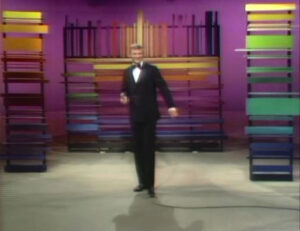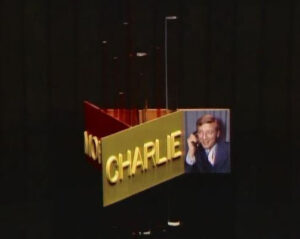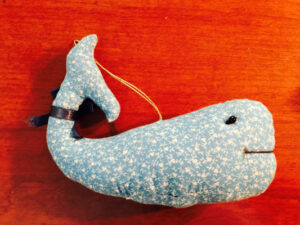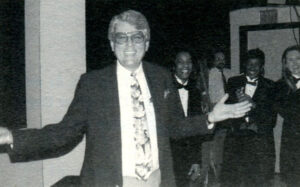
Art Anderson. His work was his name. He was an artist who creatively put an exclamation point on every visual element representing Capitol Broadcasting Company. Many of CBC’s divisions still carry the logos created by Art.
Art was the lead artist and assistant promotion director at WRAL-TV from February 16, 1960 to January 4, 1993. In 1960, the station was still in its infancy. The broadcasts were in B&W and local programming was either live or taped “live.” Each show needed a set and Art designed it. Each show needed a logo and Art, or his team of artists, designed it. Every graphic that appeared during the newscast, including courtroom artist’s renderings of high profile trials, would be made during the day and ready for air during the evening newscast. Don’t forget promotion, where print ads were created for newspapers and the TV Guide. On-air promos carried graphic branding of WRAL. Keep in mind, this was before the age of computers. So much was created by hand and typeset.
 The Charlie Gaddy Show set
The Charlie Gaddy Show set
Art’s sets were legendary. His ability to create depth and space along with a stunning array of color made his sets look like something straight out of Hollywood. Take a look at the set (left) for the 1971 entertainment special “The Charlie Gaddy Show,” which easily could have been used for CBS’ Sonny and Cher Show.
 Good Morning Charlie show opening
Good Morning Charlie show opening
The opening sequence for the live program “Good Morning Charlie” is another example of Art using 3D elements and then creating motion by placing the objects on a turntable. In 1970, Art was ahead of his time.
Back in the day, the art department was located on the second floor of the broadcast building where engineering is currently located. The promotion department was the next door down the hallway. During my era (1981-87) Art oversaw three creative people; Doug Peedin, John Hardee, and Roxanne Hicklin. Roxanne became the first Dubner operator for the station, and WRAL was one of the first television stations in the country to have a one. ABC network had the first one. The arrival of the Dubner marked the beginning of computer generated animation for WRAL. Art totally embraced the technology.
Art was a collaborator. He always consulted with directors and producers before making a graphic. He and his staff did not want to create a visual element that would cause logistical problems during a live production, especially a newscast. As a director, I appreciated his consideration in thinking about the logistical impact further down the production path. He used the same approach whenever he designed a set. Art would talk with each director to make sure the set and camera angles complemented each other. A perfect example is the set he designed for “Live at Noon.”
 Live at Noon set: (l to r) Meteorologist Bill Schmidt,
Live at Noon set: (l to r) Meteorologist Bill Schmidt,
Ray Wilkinson, Denece Boyer, John Hudson.
Kevin Shand served as the producer of Live at Noon. He recalls the phrase “warm and fuzzy” being bantered about by management in regards to what the set should impart to the viewer. As Kevin recalls, “Art pushed back to the use of that phrase. To Art, ‘warm and fuzzy’ dulled the images and softened the set to the point of being too subtle.” Art staged sets with strategic placement of items to lead the eye to the hosts and guests, yet provide a visually inviting background. The foreground was to be seen, and the background was used to enhance and complement the foreground. It was a visual balancing act.
The set of “Live at Noon” was a perfect example of Art’s design aesthetic. It was visually appealing, not only due to the décor, but due to the layers of depth he created with space and “see through” areas that tricked the viewer’s eye to draw them into the “room.” We all said, “We want that room in our home!”
Art was a dapper dresser. He always looked like he just stepped off the cover of GQ Magazine. However, he was not above rolling up his French cuffs and sleeves for some hands on-work. Art’s continuity of graphic branding was seen on WRAL News ranging from SKY 5 to LIVESTAR 5, news cars, news microphone flags, and strategically positioned logos in the newsroom, on caps, newscast graphics and the list goes on. To this day, WRAL branding reflects some of the key basic elements Art established years ago.
Art Anderson working on the first SKY 5
Above and Beyond print ad featuring SKY 5 and LIVESTAR 5: SKY 5 #2 and LIVESTAR 5 sporting the WRAL graphic scheme.
Art had a sharp wit. I recall him talking about how he relieved stress at the end of the day. He said that after a hectic day he would go home and prune his Bonsai (miniature) trees by twisting their little branches. It was the way he said “twisting” that you knew Art had experienced a frustrating day. Note: No Bonsai trees were injured during the twisting. Art was a man of peace.
Phyllis Parish, Director of WRAL Local Production, shares her fond memories of Art:
Art was a wonderful mentor and friend. When I came to work at WRAL in 1982, I was the new kid on the block, a recent college grad with just a year’s worth of Promotion experience from the local NBC affiliate. Art took me under his wing and made me feel welcome right from the start. The Promotion and Art Department offices were side by side, so I was lucky to see and work with Art and his talented team of artists, Doug Peedin, Roxanne Hicklin and John Hardee, every day. They had decades of broadcasting experience between them, so I learned about “the big 5” and soaked up advertising and design tips from the best.
 Whale ornament
Whale ornament
But what I remember most about Art Anderson was his big heart. He was genuinely kind. Early on, he learned about my interest in whales. I had seen my first humpback whale during my family’s trip to Hawaii. I had a big collection of whales – wooden, glass, marble, you name it. Art surprised me with a cute little whale Christmas ornament. Each Christmas season, I think of Art when we decorate our tree, and I remember my mentor, colleague and friend.
 Art Anderson on the day of his retirement, his last day at WRAL.
Art Anderson on the day of his retirement, his last day at WRAL.
Art Anderson rang in the new year of 1993 by retiring from WRAL on January 4. His going away present from CBC was a kiln. He moved to the small community of Burnsville, known as an artist’s community, and became a potter and jewelry maker; once again creating art by using his hands.
Art passed away unexpectedly on Monday, September 17th, 2012. He was 74. However, his legacy of art continues to be appreciated here at Capitol Broadcasting Company.
Below are more examples of the work that came out of the Art Department with Art at the helm.
1988 News Anchor Adele Arakawa
1988 News Anchor Charlie Gaddy
Local programming Ad
Local programming Ad
Christmas cartoon designed by Art Anderson
Final logo design for Carolina News Network
Ad for news feature
Ad for news feature
Ad for news feature
Design for solid bronze coin commemorating the first day of broadcast from WRAL’s 2000 ft Tall Tower on September 11, 1978.
Design for solid bronze coin commemorating the first day of broadcast from WRAL’s 2000 ft Tall Tower on September 11, 1978.
Thanks to Corp’s Pam Allen for this capcom story. Pam Parris Allen is a former WRAL newscast producer/director who now works as a researcher and producer on the CBC History Project.